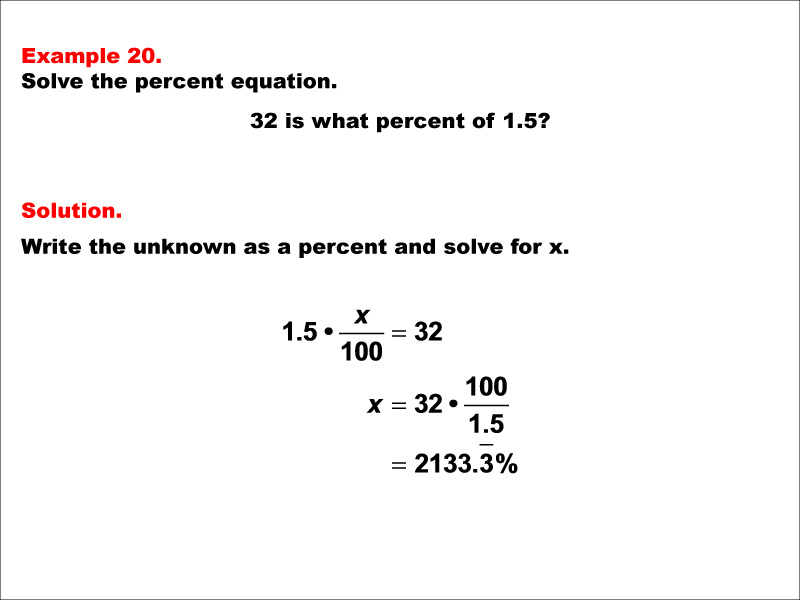
Display Title
Math Example--Percents--Equations with Percents: Example 20
Display Title
Math Example--Percents--Equations with Percents: Example 20

Topic
Solving Equations
Description
This math example demonstrates solving percent equations by asking "32 is what percent of 1.5?" The solution involves setting up the equation 1.5 * (x / 100) = 32, then solving for x to get x = 32 * (100 / 1.5), which equals 2133.3%. This example introduces a scenario where the resulting percentage is significantly larger than 100% and involves a decimal base number less than 1.
Solving equations with percents is a fundamental skill in mathematics that has wide-ranging applications in finance, statistics, and data analysis. These examples help students understand how to set up and solve equations involving percentages, especially in cases where the result is a large percentage due to a small base number. This skill is crucial for more advanced mathematical concepts and real-world problem-solving scenarios, such as calculating extreme percentage increases, analyzing rapid growth rates, or understanding relative values in various contexts where there are significant differences in scale.
The importance of presenting multiple worked-out examples cannot be overstated. Each new example reinforces the concept while introducing different scenarios, including those with decimal numbers and very large percentages. This approach helps students recognize patterns, adapt their problem-solving strategies, and gain confidence in their ability to handle diverse percentage-based calculations. By practicing with various value pairs, including those that result in percentages well above 100%, students develop a more comprehensive understanding of how percentages relate different quantities and prepare for more complex mathematical challenges they may encounter in higher education or professional settings.
Teacher Script: "Let's tackle this challenging percent problem. We're asked, '32 is what percent of 1.5?' To solve this, we set up the equation 1.5 * (x / 100) = 32. Now, how do we solve for x? We multiply both sides by 100/1.5. This gives us x = 32 * (100 / 1.5), which equals 2133.3%. Notice that our result is a very large percentage, over 2000%. This means that 32 is more than 21 times larger than 1.5. In real-world scenarios, you might encounter situations where you need to express one value as a percentage of a much smaller value, often when calculating extreme growth or increase rates. For example, if a start-up company's valuation grew from $1.5 million to $32 million, you could say they experienced a 2133.3% increase in value. Understanding these concepts is crucial for analyzing rapid growth rates, comparing values across vastly different scales, and interpreting proportions in various fields like technology start-ups, exponential growth models in science, or extreme market fluctuations in economics."
For a complete collection of math examples related to Solving Equations click on this link: Math Examples: Equations with Percents Collection.
| Common Core Standards | CCSS.MATH.CONTENT.6.EE.B.5, CCSS.MATH.CONTENT.7.RP.A.3, CCSS.MATH.CONTENT.6.RP.A.3.C |
|---|---|
| Grade Range | 5 - 8 |
| Curriculum Nodes |
Algebra • Expressions, Equations, and Inequalities • Solving Percent Equations |
| Copyright Year | 2013 |
| Keywords | Percent, equation, solution, solving equation, percentage |